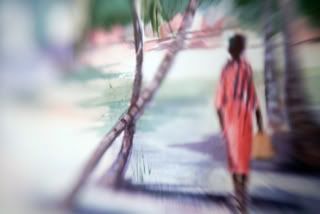
Looking back over my past blog entries, I've noticed an Italian theme weaving through. It's quite accidental, of course, as I choose my recipes at random when something catches my eye. It could be the way a certain dish is styled, an ingredient that is in season, a serving dish, or any number of reasons. Just the name of the recipe can tempt me as did for this post.
Torta Aperta.
Torta means cake in Italian, Spanish and Bulgarian and Aperta means open. Open Cake certainly doesn't sound as romantic as
Torta Aperta-sweet yeast bread filled with dried cherries macerated in Amaretto, diced ripe mango and sprinkled with turbinado sugar.
Made from a simple sweet yeast dough formulated by Mary Ann Esposito, star of the PBS show
Ciao Italia and guest teacher at
King Arthur Flour Baking Center in Norwich, Vermont, the
Torta Aperta is perfect for breakfast with family or friends or as a dessert topped with ice cream.
 Simple Sweet Dough
Simple Sweet DoughYield: 2 1/2 pounds of dough, enough for two large pies
2 1/4 teaspoons active dry yeast
1/4 cup (2 ounces) warm 110 to 115 degrees 1% milk
3 large eggs, at room temperature
4 1/2 to 5 cups King Arthur Unbleached All-Purpose Flour
1/2 cup (3 ounces) sugar
1 1/2 teaspoons salt
8 tablespoons (4 ounces, 1 stick)unsalted butter, softened
In a medium bowl, sprinkle the yeast over the water and mix with a spoon until the yeast dissolves. Let the mixture proof for about 5 minutes, until small bubbles begin to form. Stir in the milk. With a fork, beat in the eggs one at a time. Set aside.
In another bowl, mix together 4 cups of the flour, the sugar and salt. Break up the butter over the dry ingredients and work it in with your hands until the mixture is crumbly. Add the yeast mixture and mix with your hands until you form a ball of dough. Add additional flour if necessary to obtain a dough that is soft, but not too sticky.
Lightly spray a large bowl with cooking oil or spray or lightly coat with butter. Gather up the dough, place it in the bowl and turn to coat. Cover bowl with plastic wrap and let the dough rise until doubled in size, 2-2 1/2 hours.
When the dough has risen to approximately two times its size, use two fingers to make two indentations into the center of it. If the indentations do not close up, the dough is sufficiently risen and ready to use. Divide into two pieces. One piece will make the following Torta Aperta. If you want to make two pies with this dough, double the filling and use entire Sweet Simple Dough recipe.
Torta ApertaDough
1/2 recipe Simple Sweet Dough
Filling
1 cup dried cherries
1/4 cup amaretto liqueur
1 large mango, peeled, pit removed and diced
1 egg, slightly beaten
1 tablespoon turbinado(coarse brown) sugar
Place the cherries in a small bowl and pour the liqueur over them. Stir well and let macerate at least 1 hour.
Roll the dough out into a 15-inch circle. Carefully lift dough up and place it in a 10-inch shallow pie plate. Glass or ceramic plates are good. Let the excess dough hang over.
Add the mango pieces to the dried cherry mixture and spread the fruit with its liquid over the dough. Using scissors, cut 2-inch slits in the overhanging dough all around the dish leaving the center open. Cover with a towel and let rise 35 minutes.
Preheat oven to 375 degrees F. Brush the top of the dough with the beaten egg and sprinkle the turbinado sugar over it. Bake for 30-35 minutes until it is golden brown and firm to the touch. Cool completely. Cut into wedges to serve or remove entire pie from pan by running a knife around the edges of the dish and with a spatula, carefully lift the pie onto a serving dish.
Recipe From The Baker's Companion Magazine-Spring 2007











